Náš hlavní partner Megapixel.cz se rozhodl nafotit svůj vlastní týden života s názvem Tak žije Megapixel a přiblížit vám tak každodenní radosti i starosti této společnosti.
Archiv autora: Zdeněk Kamrla
Hledání světla ve tmě s kevinem v. tonem
kevin v. ton, Grafik, Česká republika
Rubrika Mistři Week of Life je snad nejostřeji sledovaná sekce na našem portálu – co do obsahu sdělení fotografií, tak i do celkového umu zvládnout celé zadání našeho projektu. Proto není pravidelná a musíme vždy čekat, až se vynoří někdo nový. Někdo, kdo svými fotografiemi, ale i svou osobností, kterou do svých fotografií vtiskne, přinese materiál, který stojí za pozastavení, za prozkoumání, za vyzpovídání! Takovou osobnost jsme spatřili v osobě grafika s trochu tajemným jménem, nebo spíš uměleckým pseudonymem, kevina v. tona. Dlouho jsme se rozhodovali, pak rozhodli a po přečtení jeho odpovědí si potvrdili, že nejen rozhodnutí na základě jeho fotografií bylo tou správnou volbou.
Jak jste se dozvěděl o projektu Week of Life a co Vás přimělo se do něho zapojit?
O projektu Week of Life jsem se více dozvěděl někdy v půlce října loňského roku od mého dávného kamaráda z jihu Čech. Sice jsem už před tím něco málo zaslechl, ale nic bližšího, nic konkrétního, co by přitáhlo moji pozornost. Právě na návštěvě u něj, když mi na monitoru ukazoval svůj připravovaný týden, když jsme si prohlédli na stránkách WoL vystavené týdny dalších fotografů a když jsem zjistil, že jde o projekt pana Ziky, jsem se rozhodl též se pokusit zapojit. A během čtrnácti dnů jsem opravdu začal. O tom, že na projektu pracuji, nikdo nevěděl, a i v rodině se to dozvěděli až po několika měsících, kdy už byly všechny snímky naskenovány a celý týden připraven k publikování. Nápad sloučit výsledky týdenního výtvarného dokumentárního vidění fotografů roztroušených po celém světě “pod jednu střechu” mi přijde nejen unikátní, ale i velice potřebný. To, že je možné sledovat jednotlivé všední žití v průběhu dne a týdne ze všech koutů naší planety, umožňuje zároveň lépe si uvědomit skutečnost, že tam všude žijí lidé. Lidé se svými všedními radostmi i starostmi bez ohledu na barvu pleti, režim, do kterého se narodili, či ekonomickou situaci země, ze které pochází.
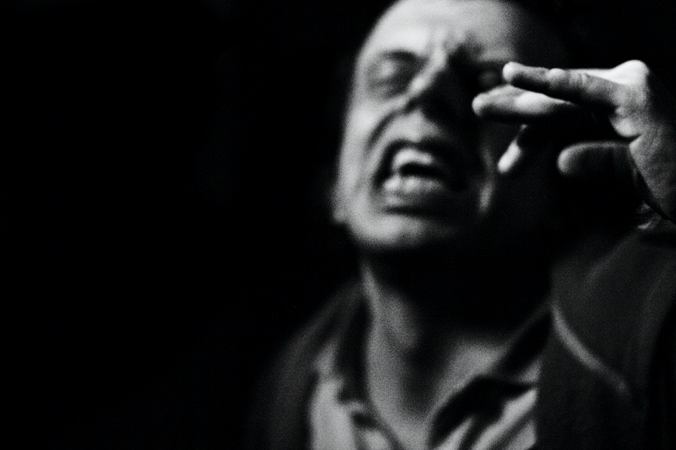
Pracujete jako grafik. Můžete upřesnit o jaký obor grafiky se jedná?
I když sám sebe považuji především za fotografa, živím se hlavně jako výtvarník, kreslíř, typograf, počítačový grafik. Každá zakázka obsahující v zadání tvůrčí svobodu je pro mě výzvou, ať se jedná o obal CD začínající nezávislé kapely nebo o corporate identity prosperující společnosti.
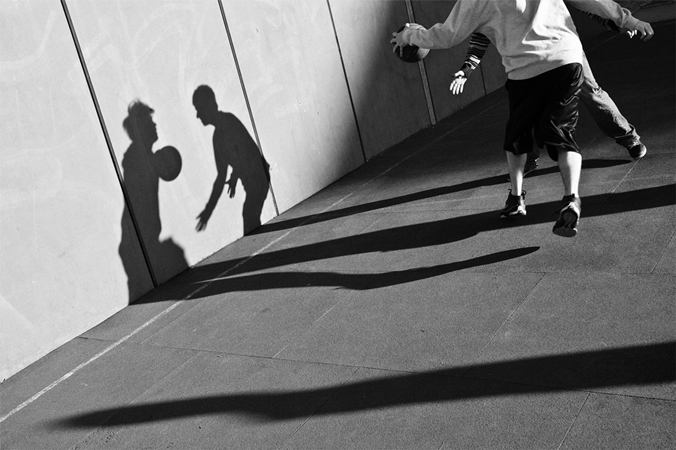
Svůj první černobílý týden jste jako jeden z mála nafotil na film. Co Vás k tomu vedlo, mělo Vaše rozhodnutí nějaký hlubší význam?
S negativním černobílým filmovým materiálem pracuju skoro čtvrt století a stále velice rád. Za tu dlouhou řádku let jsem se naučil tahat s sebou jednu či dvě obstarožní F3 od Nikonu a k tomu jednu emkovou Leicu. Na každém těle jiné sklo a v každém jiný film. Nejčastěji používám ilfordí Delty – čtyřstovku a třitisíce dvoustovku a pak Neopan šestnáctistovku. Pořád mám pocit, že jejich jedinečné charakterové vlastnosti včetně výsledného vizuálního vzhledu těžko kdy vůbec digitální záznam nahradí. Dokumentární fotografie a filmový záznam jsou jako nevěsta se ženichem – dohromady mohou tvořit dokonalý pár, rodinu, která je schopná přivádět na svět nádherné potomstvo v podobě úžasných fotografií. Přesto však digitální fotoaparát používám a poctivě si pro sebe hledám jeho kouzlo, které v sobě bezpochyby také musí mít. A třeba díky práci na mém filmovém týdnu v rámci projektu WoL už jsem i jedno našel. Tím je pro mě rychlost zpracování zaznamenaných dat.
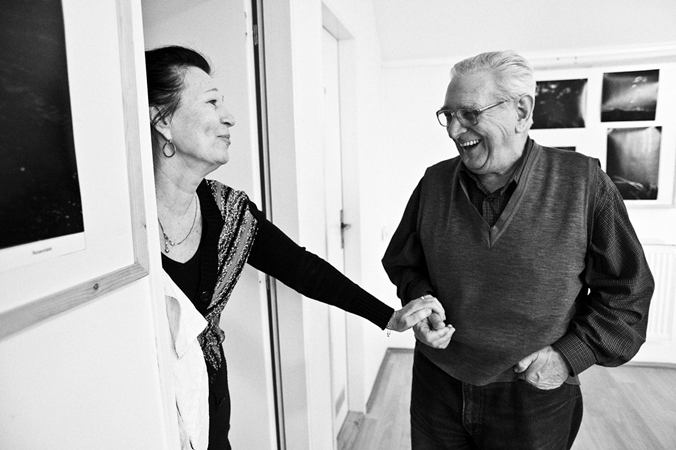
Je velice příjemné číst, že někdo v dnešní době ještě takto věří negativu a klasické fotografii. Povězte mi více o Vašem názoru na to, jak se situace bude vyvíjet do budoucna, zda přijde jednou konec analogu nebo budou s digitálem spolu navěky?
Trochu zapeklitá otázka, krapet spíše o předpovídání budoucnosti. Osobně jsem ovšem přesvědčen, že ještě dlouho půjdou světem společně ruku v ruce analogový a digitální záznam. A pevně v to doufám. Jde o podobnou situaci, jakou s nástupem cédéček a digitalizace v hudbě počátkem osmdesátých let zažilo staré dobré elpíčko. Přes ohromný ústup z trhu se dodnes, i po třiceti letech, gramofony vyrábí a desky lisují a oboje se prodává. Pořád je naštěstí na světě dostatek lidí, kteří mají rádi zvuk desky i s jejími “nešvary” jako je škroupání, skřípání, vrzání a třeba i potřeba manuálního otáčení k poslechu druhé strany. Cédéčko tyhle mouchy nemá, ale zas mu chybí cosi, co člověk často i bytostně potřebuje. Prvek náhodnosti, narušení stereotypu. Podobné je to s i kinofilmem, či s filmovým materiálem jako takovým. Co se mu někdy vyčítá jako nedokonalost, vnímám jako klad. Omezení na šestatřicet snímků člověka naučí vnímat situaci koncentrovaně, všemi póry, soustředit se na podstatu, výsledný snímek vidět v hlavě ještě před jeho exponováním. Třeba i proto, že vyměnit film přece jen chvilku trvá. Pro jeho vlastnosti vybírám si ten film, který dané scéně nejlépe vyhovuje. A škrábance jsou prostě třešinkou na dortu. A vždycky se dají vyretušovat. Digitál, na rozdíl od analogu, umožňuje enormní nárůst kvantity, ovšem nikoliv se zárukou vyšší kvality. Ve skutečnosti je v podstatě celkem jedno, jaký se používá nástroj, zda analogový nebo digitální. Důležitý je obsah. Sdělení. Moment, který mluví. Divák primárně nepotřebuje vědět z pozadí vzniku snímku vůbec nic, je to jen technická záležitost. Divák obraz buďto přijme, a nebo ne.
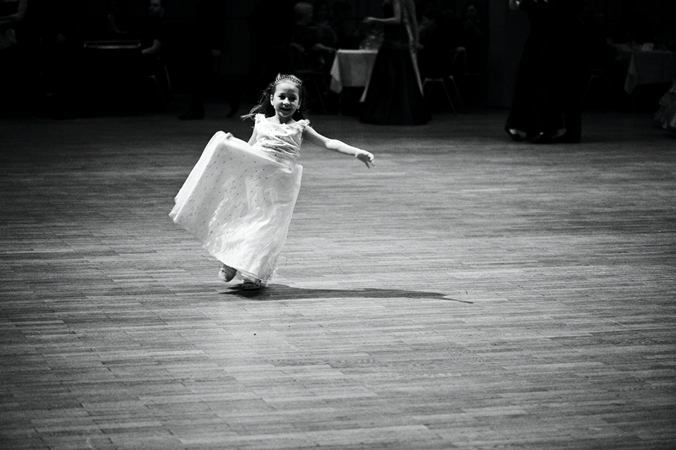
Na vašich fotografiích je vidět, že se nebojíte práce s tmavými situacemi, s atmosférou v noci. Máte nějaký větší vztah k černé nebo k sytým tmavým barvám?
Nemyslím, že bych měl nějaký stálý, výraznější vztah k jakékoliv z barev, potažmo pak k barvě černé, třeba oproti bílé, když už jsme u mých, povětšinou černobílých fotografií. Tyto dvě barvy jsou protipóly, jeden bez druhého nemůže být. Jing a jang. Ovšem hledání člověka ve stínech noci, hledání pravdy nasvícené pouličními lampami, výlohami opuštěných obchodů, pomrkávajícími neóny či světly projíždějícíh aut, hledání člověka v temných zakouřených hospůdkách, v zákoutích ztichlých měst, tak tohle hledání světla ve tmě, to mám rád. Syrovost prostředí. Autenticitu. Momenty, kdy nekašírované lidské touhy a potřeby vystupují ze šera noci.

Vaše „babička opírající se o zeď“ byla zařazena jako titulní fotka Výběru redakce. Nelze si také nepovšimnout bezdomovce v dece pod lampou a další fotografie na toto téma. Máte sociální cítění, fotíte rád „v podpalubí“?
Zajímá mě především člověk. Člověk a jeho úděl, jeho místo na slunci, naplnění jeho snů i dopad jeho proher. Hledám podstatu. Podstatu lidství. Hledám člověka, ať je kdokoliv, ať je kdekoliv, ať je čímkoliv. Hledám člověka v člověku.
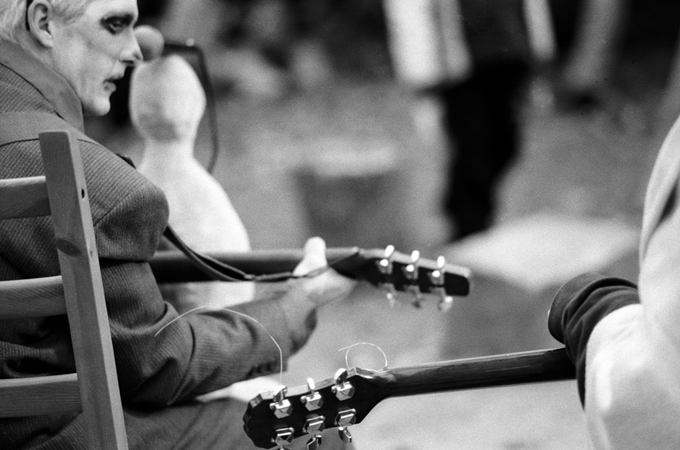
Vaše fotografie jsou emotivní a vyvolávají v člověku reakce, což je jistě hlavním účelem dokumentu. Myslíte, že Week of Life má možnost a nebo alespoň šanci vyvolat v budoucnu v lidech emoce, pocity, zamyšlení a udělat svět třeba o kousek lepší?
Week of Life je velice zajímavý projekt a má v sobě po dokumentární stránce ohromný potenciál. Jak už to u dokumentu často bývá, jde o běh na dlouhou trať. A u Week of Life jde vlastně o trať nekonečnou, obíhající nespočetněkrát celou zeměkouli. Možnost prohlédnout si svět očima jiného kolegy fotografa, žijícího třeba přesně na opačné straně naší Země, je úžasná. Podaří-li se dlouhodobě udržet nastavenou fotografickou laťku vysoko, případně ji ještě zvedat, a nesklouzne-li časem projekt k výměně víceméně rodinných snímků, doplněných vysvětlujícím vyprávěním pro snažší pochopení, tak jako u jiných sociálních sítí, stane se velkolepým fotografickým archívem, dokumentem, který nemá svým rozsahem obdoby. Emoce, pocity a zamyšlení vyvolává WoL již dnes a pevně věřím, že možnost poznávat se navzájem i touto fotografickou cestou může napomáhat k odbourávání různých předsudků či zaběhlých názorových stereotypů a tím přispět k posunu v myšlení celého lidstva a opravdu svět udělat, byť třeba jen o kousek, lepší.
 |
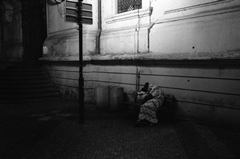 |
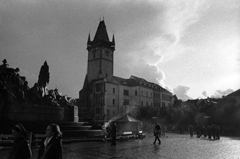 |
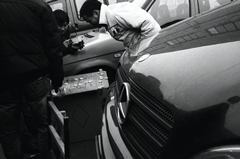 |
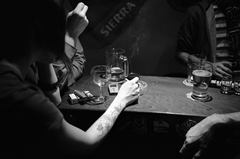 |
 |
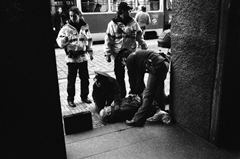 |
 |
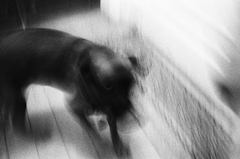 |
Joao Carlos
Když posledního ledna 2010 odborná porota v čele s Antonem Corbijnem a Stevem McCurrym oznámila deset jmen Hasselblad Masters 2009, byl Joao Carlos mezi nimi…
Nelenil jsem
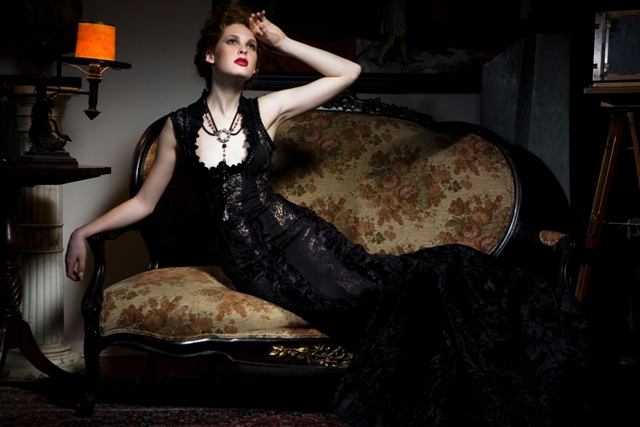
Jakmile společnost Hasselblad už podeváté za sebou oznámila vítěze své prestižní soutěže Masters Award, uvědomil jsem si, že vás o tuto exkluzivní fotografickou událost nesmím připravit. A protože přední světoví profesionálové zaslali své snímky do deseti kategorií, měl jsem logicky výběr z deseti velmi kvalitních vítězů oněch kategorií. Má volba padla na Joao Carlose a myslím, že to nebyla volba špatná. To posuďte sami.
Ale ke kategoriím…
Loňský ročník Hasselblad Masters se vyznačoval nejen nezvykle vysokou kvalitou a vyrovnaností soutěžících, ale i excelentní porotou, která měla spoustu práce s výběrem těch nejlepších z finální stovky profesionálů (počet přihlášek prý přesáhl tři tisícovky, tedy dvojnásobek oproti ročníku 2008). Rozhodovala kreativita, kompozice, síla koncepce a technické provedení. Nebudu vás ale napínat. Vítězové jednotlivých kategorií jsou:
Architecture – Stephan Zirwes, Stuttgart, Německo
Editorial – Nina Bergman, New York, USA
Fashion/beauty – Dirk Rees, Londýn, Velká Británie
Fine art – Quentin Shih, Peking, Čína
General photography – Mark Zibert, Toronto, Kanada
Nature/landscape – Bang Peng, Hongkong
Portrait – Claudio Napolitano, Miami, USA
Wedding/social – Joao Carlos, New York, USA
Product – Mark Holthusen, San Francisko, USA
Up-and-coming – Lyle Owerko, New York, USA
S většinou těchto vítězů a s krásnou výstavou jejich prací bychom se měli setkat (ještě to není potvrzeno) na Photokině v Kolíně nad Rýnem…
A kdo je Joao Carlos?
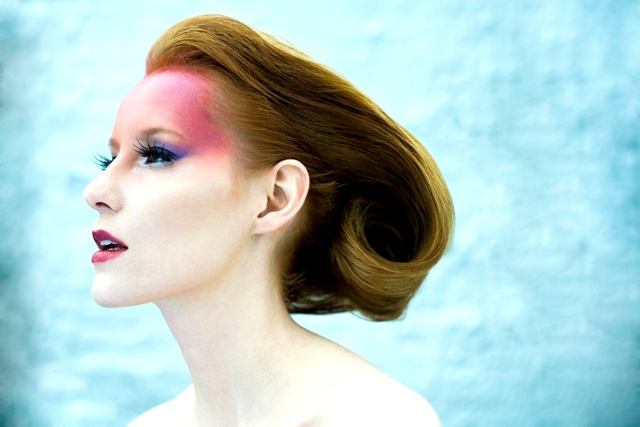
Na titulní straně svého webu píše, že by chtěl vyprávět příběhy prostřednictvím svých fotografií…Opravdu není průměrným a běžným fotografem. To mohu potvrdit. Je vizionářem v pravém slova smyslu, tak trochu fotografujícím rockerem a hlavně je velkým, kreativním živlem. Narodil se v New Yorku portugalským rodičům, pracuje zde, ale do Evropy a do Portugalska se rád a často vrací pro témata a inspiraci. Jeho inspirací je malba a malířství (často až 18. století), používá převážně přírodní světlo a snaží se o stále nové a nové, vizionářské fotografické příběhy. Výčet jeho prací je téměř nekonečný, a tak jsem vám vybral pár snímků z vítězné kolekce Hasselblad Masters a pár dalších…
Přeji vám krásnou podívanou,
Rudolf Stáhlich, šéfredaktor časopisu FotoVideo
Mediální partner:
![]()
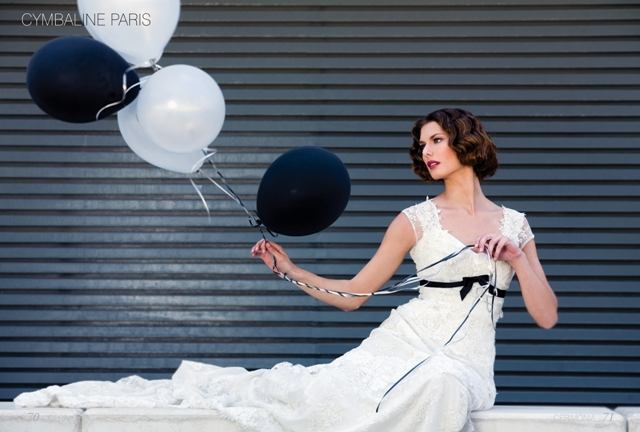 |
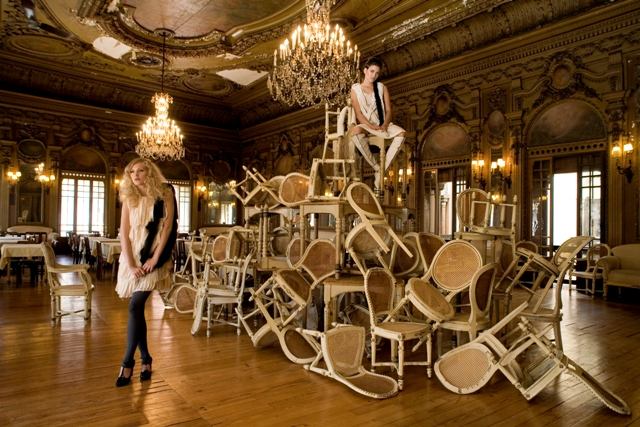 |
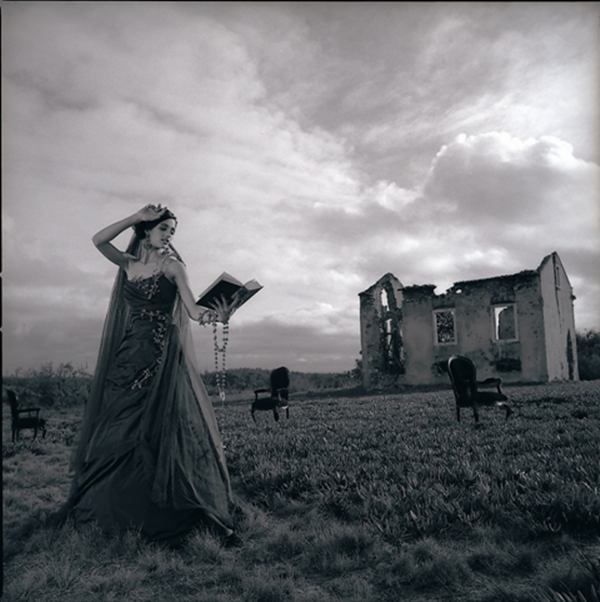 |
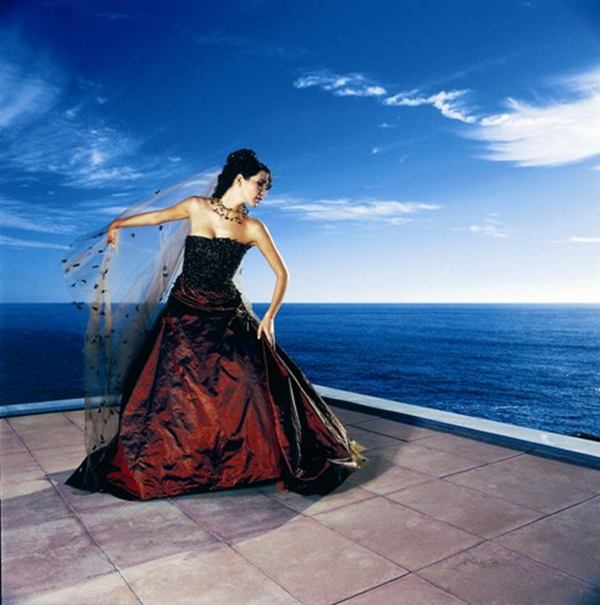 |
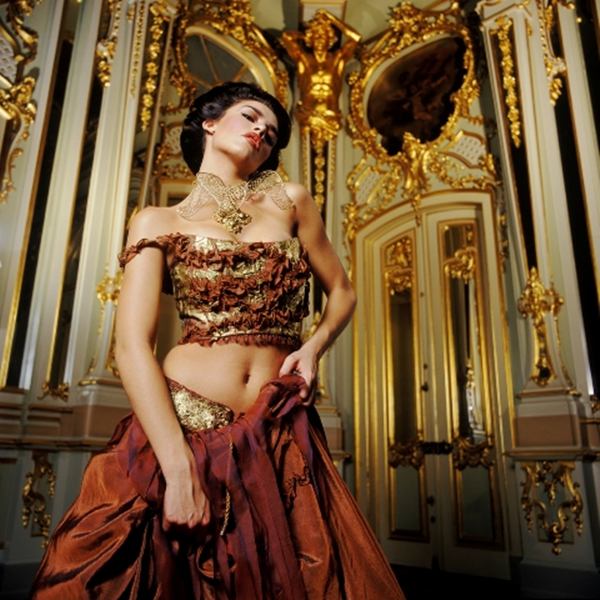 |
Fotografování krajiny – Sníh 2
Použití korekce expozice
Čistě bílé zasněžené scenérie bývají překrásné. Není tak těžké je vyfotografovat, ale může být obtížné zachytit onu bělostnou čistotu. Následující technika vám umožní docílit sněhobílého vzhledu snímku.
Použití korekce expozice k posílení dojmu ze sněhobílých plání
Většina fotoaparátů je vybavena funkcí Korekce expozice. Bělost zvýšíte jednoduše nastavením směrem k [+]. Buďte ale opatrní, protože by výsledkem mohl být snímek, jehož vzhled by neodpovídal realitě. Pokud bílou barvu posílíte příliš výrazně, může se ztratit veškerá kvalita sněhu, takže při nastavování kontrolujte výsledný efekt na displeji.
Funkce Korekce expozice mění jas obrazu. S její pomocí můžete změnit náladu snímku nebo vzhled objektu. Zasněžené scenérie jsou jedním z příkladů, pro které je obtížné nastavit korekci expozice. Nastavením směrem k [+] můžete docílit bělejšího, jasnějšího snímku, ale přílišné posunutí expozice může vést k přeexponování. Pro jistotu můžete pořídit několik snímků s různým nastavením.
Změna vzhledu zasněžené scény pomocí Korekce expozice
 |
 |
 |
 |
 |
 |
 |
Co je dobré vědět
- Přílišná korekce směrem k [+] může zapříčinit přeexponování. U některých modelů fotoaparátů můžete kontrolovat přeexponování na displeji po pořízení snímku, jiné modely umožňují kontrolu pomocí histogramu při pořizování snímku.
- Velmi užitečnou funkcí je „auto bracketing“, která umožňuje pořídit v řadě za sebou několik snímků s různými nastaveními. Funkce pořídí několik snímků za sebou a vždy automaticky změní hodnoty nastavení. To oceníte zejména v případech, kdy je obtížné nalézt optimální nastavení fotoaparátu. Otevřete „Užitečné tipy: Používání funkce auto bracketing“.
Taking Pictures of Landscapes – Snowscenes 2
| Snow scenes in pure white can be very beautiful. It’s also not that hard to take pictures of them, but it may be difficult to capture that pure-white look. |
Taking Pictures of Landscapes – Snowscenes 2
Using Exposure Compensation
Snow scenes in pure white can be very beautiful. It’s also not that hard to take pictures of them, but it may be difficult to capture that pure-white look. Try this technique to get the snow-white look in the picture.
Using Exposure Compensation to Bring Out the Look of Snowfields
Most cameras include the Exposure Compensation function. You enhance the whiteness simply by adjusting towards the [+]. But be careful as this may result in a picture with a look different than in reality. If you emphasize the white color too much, the whole quality of the snow may be lost so check the effect on the monitor while making the adjustment.
The Exposure Compensation function changes the brightness of the picture. Using it you can alter the impression of the picture or the condition or look of the subject. Snow scenes are one example of the subjects for which it is hard to adjust the exposure compensation. By adjusting towards [+] you can get a whiter, brighter picture but doing it too much can result in overexposure. To be on the safe side you can take several pictures with different adjustment values.
Changing the look of a snow scene using Exposure Compensation
 |
 |
 |
 |
 |
 |
 |
Useful things to remember
- Adjusting too much towards [+] can result in overexposure. On some models you can check for overexposure on the playback display after taking a picture, and other models allow you to check the white balance using a histogram while taking pictures.
- Auto bracketing is very convenient to take several pictures at different adjustment values. The auto bracketing function takes a number of pictures changing the adjustment value automatically. This can be handy especially when it is difficult to find the best adjustment value. Open "Useful Tips: Using the auto bracketing".
Live weight
There’s always something happening at the Prčík household. Mr. Prčík is simply that sort of person who cannot spend his entire day in front of a TV or in a pub with a beer in his hand. This may be one of the reasons behind owning not only a pig, hen and goats, but also three horses.
his ‘animal farm’ obviously consumes a whole lot. Self-produced hay is long gone and therefore, it is purchased in bulk. It is then stacked in the hay-loft above the stable with a fork lift. It’s important to measure both height and length, so that the hay actually fits into the door. Physics plays its part here and so does the lever along with gravitation. The front of the tractor is light and tends to flip over when dealing with heavy loads. Initially, a 50kg weight is placed on the front axle to balance it out. However, with these heavy loads it’s not enough. So, most of the time, it was my wife Lenka who dropped in and assumed the role of the so-called ‘live weight’. This bale of hay however, extremely compressed and hence very heavy, needed an even larger weight to balance the tractor out, so I stepped in myself. My 80kgs next to the original 50kg weight was still not sufficient. The front wheels of the tractor still appeared to float in the air. What now?
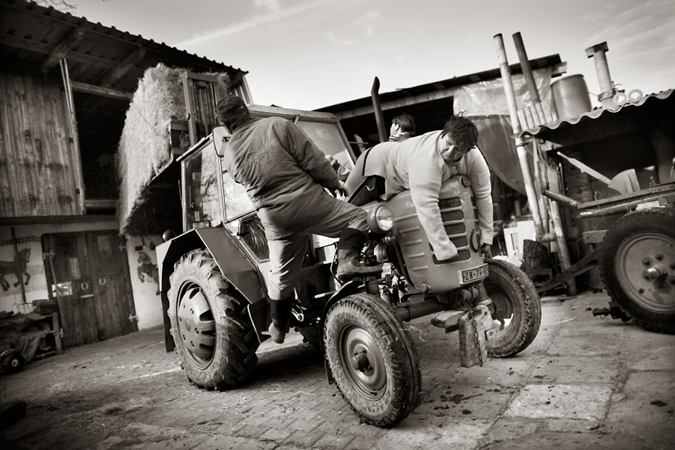
Someone from the crowd said: ‘Well, it’s time for grandma (Mrs. Prčíková) to get on the tractor’. Naturally, it was an exaggeration for the moment and humor was the only intention. But who would have thought that at that precise second, she would hop on a platform and climb onto the front of the tractor without hesitation and any real problem. She lay down on her belly and presented herself as ‘live weight’ for the first time in her life. The bale of hay was under the roof in no time and grandma was able to climb down again.
Simply speaking, this was an incidental moment typical to life in the village, where everyone needs to be practical and deal with obstacles on their own, even if it means using your grandma as ‘live weight’.
Živé závaží
U Prčíkových se pořád něco děje. Pan Prčík je člověk, který nedokáže prosedět den u televize nebo jej strávit u pivečka v hospodě. I to je jeden z důvodů, proč má v hospodářství kromě prasete, slepic a kozy i tři koníky.
Ti samozřejmě něco spořádají. Seno z vlastní produkce již dávno došlo a tak se seno kupuje ve velkých balících. Ty se pomocí vysokozdvižných vidlí uskladňují do seníku nad stájí. Je nutné je postavit na výšku a na délku, aby se do vrátek vešly. Tím se projeví fyzika. Páka a gravitace udělají své. Předek traktoru je lehký a tak se u těžších balíků začíná převracet. Nejdříve se dá asi 50 kg závaží na přední nápravu. Jenže u těžších balíků to nestačí. Většinou zaskakovala jako živé závaží moje žena Lenka. U tohoto balíku, který byl extrémně slisovaný a tím i těžký, jsem naskočil já. Mých 80 kg a závaží nestačilo. Přední kola traktoru šla stále vzhůru. Co teď?
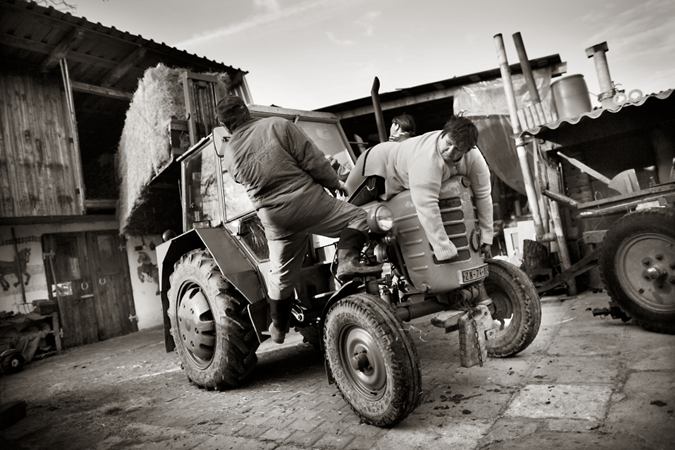
Padla hláška, tak a teď tam musí babička (paní Prčíková). Vše bylo myšleno s humorem a nadsázkou. Jenže ona vyskočila na stupínek a přední část traktoru bez problémů vylezla. Lehla si na břicho a udělala tak poprvé v životě živé závaží. Po několika minutách byl balík pod střechou a babička zase slezla.
Prostě neplánovaný moment ze života na vesnici, kdy si člověk musí poradit po svém.
New section: Authors´column
The author’s column is of a different nature than other sections of Week of Life. It’s that very part which should ponder about the essence and the endeavor regarding the viability of this colossal documentary project, with WoL surely deserving such praise, having witnessed many aspects of human life and different fates. The columns and their authors respectively, should derive their thoughts from this very idea, draw the energy from the photos themselves and thereafter process that and put on paper in a way typical of their narrative style, presenting us with advice, suggestions, the knowledge they’ve gained or simply ‘just’ their prudent ideas. These ideas should not only be educational, but perhaps also a little scientific. They should not be beneficial only to the people that are already a part of the WoL project, but also to those that somehow find their way here coming from a different world. Maybe then and as a result they will like it here JUST THAT BIT MORE and decide to stay.
The phenomenon of photography
Photography is perhaps the most characteristic phenomenon of our age. It’s irreplaceable in science, in the media, and has become so connected to ordinary life that we no longer ponder its multiple forms, functions and exposure. We have taken photography for granted, but at the same time, it has ironically become a significant part of our reality.
We can only assume that hopefully, the next generation will be able to absorb intellectually its indisputable role in the field of arts. They will no longer disparage photography as an artist’s means of expression or ignore it amongst other forms of art just because it has found practical uses and has been subject to mass dispersion throughout civilization.
Photography and architecture are by far the most loyal forms of art. Nevertheless, not every structure is an artistic masterpiece; the same applies to photographs. Both of these fields surprisingly have a lot in common; they create the space we flow in and determine its visual aspect. Both fulfill our needs and create new ones. Similarly, they have multiple layers of nature and character, as well as a debatable fate. We live within images, symbols and signs. Etymology explains the origin of the word photography in two Greek words: phos (light) and graphé (drawing / brush).
 |
| A picture giving face to the Great Depression, author: Dorothea Lange |
‘Drawing with light’, a person cannot resist this notion, symbolizing the genesis of a new image. No wonder we are predetermined to perceive and judge photography based on the mechanism known as artistic painting. Not only the philosophy but also the history of art is obsessed with this comparison variations of it. However, it is an attempt to pass judgment on and systematize something unknown by a proven entity. Photography is an individual factor in itself. It does not need to be compared to other aspects of art or anything else for that matter. The belief that photography is just a continuation of paintings is as pathetic as claiming that man has evolved from monkeys. Just as it was the case of human kind evolving in parallel with apes as relatives, the same applies to the evolution of photography and painting (i.e. the remark that photography is only a matter of the new modern age is short-sighted). People need to realize that the invention of ‘camera obscura’ and photography itself has come a long way.
 |
| The first photograph, author: Joseph Nicéphore Niépce |
Human nature urges us to document our existence and create, as well as to follow other significant instincts like destruction and reproduction. During the Paleolithic age, also known as the Stone Age, 2.7mil to 2 thousand years before Christ, stone was obviously the hit of the era. Our dear ancestors were amazed by stone and remained dazed by its technical possibilities. Everyone simply liked stone suddenly. ‘Stone for every family’ was probably the chant of the eldest and skilful homo habilis; the upstanding homo erectus, and, lastly, the reasonable homo sapiens. Who would have thought that ordinary stone would start off the evolution of our civilization in the direction of brighter tomorrows? The last stage of the Paleolithic era gave birth to the first cave paintings, 15 to 30 thousand years ago. This shows that humans already tended to create and document despite their limited skills and knowledge. Some of the conventionalized paintings illustrate that humans painted not only to document random things, but artistically documented their existence and reality to. They perfected their technique on clay, ash, and charcoal. Jumping a few thousand years ahead to the 7th century, it was even further perfected by oil. This is evident from the discovery by French scientists of a complex of caves in the Afghani Bamyan, where we witness the oldest oil paintings in the world—Buddhist paintings.
‘Drawing with light’
Not long after, a fair 600 years later in the 13th century, oil arrived in educated Europe. The further evolution of artistic painting is quite accurately known, since the history of art is taught in similar fashion all over Europe, and no one has really deviated from this Eurocentric precedent. Only a handful of bizarre philosophic-aesthetic theories stray away.
Where does the path of photography begin? 350 years before Christ, when Aristotle discovered the principle of camera obscura. 1,996 years later, in the year 1646, the first laterna magica was invented, and in the year 1825, Nicéphore Niépce developed the oldest known photo in the world. A rapid succession of events followed: In 1888, George Eastman patented the first box camera and introduced the first commercially successful camera designed for roll film to the market. He also registered the Kodak trademark. The first of the ‘easy to use’ products, Kodak Brownie N° 1 box camera, was advertised that same year.
In 1948, the legendary brand Hasselblad enters the market with its first product. In the same year, people were able to purchase a Polaroid with its ‘instant’ photos. 21 years later, Willard Boyle and George E. Smith invented the first CCD chip in Bell’s laboratories. Within the scope of the history of photography, this technology brings us to the present time, influencing the entire world. In 1994, the market was enriched by the first digital camera with CCD technology, distributed on mass scale: AppleQuickTake100. CCD technology – Charge coupled device – exploits the advantages of chip instead of celluloid film. In crude terms, the photosensitive circuit detects the light and converts it to an electric charge, which is then measured and converted to a digital image. This kind of system is composed of an enormous amount of ‘miniature cells’ catching light individually. The digital image is assembled from particular points – pixels; the more ‘cells’ a sensor has, the higher resolution of the resulting digital image. In other words, by this process we gain more data. As a matter of fact, the mechanism closely resembles the functions of the human eye. Thus, this is the reality of the present. The technological progress of the photographic camera cannot be confused with the history of photography, especially not with the artistic part. Nevertheless, it’s always an advantage to have at least the slightest idea about things that come across and affect our everyday lives.
 |
| A photo that destroyed one of the industrial sectors, author: Murray Becker |
The purpose of technology is to help us and make our lives easier. Today, it is as easy as ever just to pick up a camera and practically take a picture of anything we desire. As a result, the practice of photography has changed compared to previous times: Comparing the present situation to the one a hundred years earlier, we come to the conclusion that in those days, the target situations to be shot by the camera were carefully chosen, composed and arranged. Taking pictures was more of an occasional event. The outcome was usually artificial—perfectly satisfying the setup and arrangement. Today, photos are not bound to some sort of responsibility for the result. The process of photography is not as elaborate anymore and is nowhere as expensive for the ordinary person, who now has the ability to afford spontaneous and imminent images. There are no boundaries for the creative mind. Therefore, the camera’s notation of certain situations can be far more sincere than before.
Lately, the trend has reached the situation where we hear negative evaluations and opinions about the present time; that photography is heading towards a decadent slope, that its value is degraded by postproduction, that it has become profane, and, finally, that its standard has dropped both on the amateur every-day level, as well as on the artistic professional level. Sentimental memories follow, praising the days when photography was ‘worthy’.
 |
| A photo that made surrealism real, author: Philippe Halsman |
Hardly anybody realizes that these beliefs lead to a dead end. The spiritual quality of photography is not based on the technology used, since technology is not the result but only the tool. According to what you desire, you are free to choose the respective tool. If you choose to take pictures on a large light sensitive glass with a box camera and would like to return to the wet collodion process, no one will stand in your way. On the other hand, if you chose to use the Hasselblad H4D-40 and take pictures in the RAW format in the 1880s, tough luck. The present day simply offers a wider range of possibilities, nothing more and nothing less. The photography of old cannot be considered better just on the basis of being more respectable, scarce and a matter of rare occasion, since people could not simply afford any other approach. The same applies to the present day. Photography cannot be labeled as decadent just because it has expanded on a massive scale. Present day photography can’t be discriminated against based on the technological-economic aspects resulting in its affordability. The conditions are far more favorable today than a hundred years ago, true, but it is surely not the decisive and relative criterion of the consequent aesthetic experience. The gifts of progress need to be utilized without guilt and remorse. And besides, mastering digital technology requires similar expertise as handling film does, if a person wants to accomplish truly top-notch results. You need your eye and a sensibility for light no matter what. A perfect photo always stands out, no matter how many people around us own a camera.
“…sentimental memories, praising the days when photography was ‘worthy’.”
The Week of Life project allows for a wonderful thing: it enables every one of us to illustrate our week, documented by photographs, in pure democratic fashion. It creates a mosaic consisting of individuals and their photographic ‘manuscripts’. These photos show who we are, what we do, what we consider important, what we like to share and disclose to others or on the contrary, what we indirectly try to keep in our private sphere. This indirect approach tells a lot about us: how we perceive things around us, how we ‘filter’ our reality, what is our inner order of values, how spontaneous we are, or the other way around, what our abilities are when it comes to composing with reason. Week of Life works as an all-round visual exploration probe.
Members of many cultures participate on this project. Every culture predestines how we view and perceive the world around us, be it in form of the language we speak and think in or the respective religion. For example, each society has its own perception of time and moreover, every one of us individually creates an attitude of one’s self. Personally, I identify myself with Heidegger’s conception of time and life as a ‘question of being’, ‘da sein’ to be exact. I consider his theory regarding the sense of being and creation of time as the most meaningful and concise. On the other hand, we can expect a Hindu, for instance, to distance himself from my views and beliefs as he or she lives in his or her own philosophical system, and so on. The perception of time is just a small raindrop in a pool of various factors that influence our attitude towards life. Let us compare, for example, the idea of beauty of individual societies, the notions of taboo within different cultures, various habits, the terms of social coexistence, the functional models of family life, etc. etc. All of this makes us who we are as well as determines our ability to reflect upon miscellaneous events and interpret them. Therefore, all of this is considered a factor when we press the shutter of a camera. We no longer need to paint the inside of a cave; we simply hang photos on our walls.
Therefore, Week of Life gathers testimonials in the form of photographs. And after some time passes by, it would certainly be interesting to examine these photos closely and perhaps come up with several comparisons. The individual pieces both directly and indirectly predicate the status of the society and its cultural development. The potential of the ‘Week’ is substantial regarding the essence of scientific visual studies.
Furthermore, it is extremely interesting to inspect one another, as well as ourselves, while gathering memories—moments rare as well as common, and so on. Most sets also include self-portraits, as though we follow some kind of an instinct to perpetuate ourselves. The way we approach our self-portrait has a lot to say emotionally in itself. One person captures only parts of his or her body – for example, his feet at rest or his own shadow or reflection. Another person will stand in front of a mirror naked and without hesitation capture him/her self ‘totally’. Many of us decide to conceive this photographic documentary in a specific style, which is ever more interesting, since we can monitor our own games and quirks.
 |
| A photograph that enabled genius minds to have a sense of humor, author: Arthur Sasse |
Photography is a democratic medium. It captures positive events but also negative ones, as well as the occasional pathological phenomenon. Thanks to this medium we can not only inform others that we spent our vacation in the Canary Islands, but also show that children in the north of Kenya are dying of hunger and as a consequence of deadly diseases. Through the means of photography we can document such elusive moments as a snowflake melting the instant it lands on our hand. We can catch precious moments such as the first gasps for air of a new-born child. And from a different perspective, we can capture things of a cruel nature, for instance the immediate expression of a person’s face stunned by the sight of a war-infested city bombarded to ashes. A Photo never illustrates more than what really is happening in the world.
Report Kenya 2010 – 2nd part
Jiří Pergl, Enterpreneur, Czech Republic
Report Kenya 2010 – 1st part
15.1. Nanyuki
In the morning we finished food-sorting and found we have no rice, beans, nor green grams (a kind of local green berry).
I guess we counted wrong, so we return to the center of Nanyuki and buy the rest of the needed supplies so everybody gets the same amount. While the boys are sorting the food, we go with Hellen to set up an account at Standard Chartered Bank of Kenya for all our transactions, such as money transfers from adoptive parents, money to be used for various purposes (school, doctor, hospitals, etc.) and also so we comply with the requirements of Kenya’s government, which likes nothing more than to oversee any transactions where money is involved. Just to set up an account for an organization like OMDC in Kenya you need five people. Only I and our lawyer can withdraw money. Others must undersign and supply photos, ID and documentation certifying where they live. One really funny part is that the bank does not make copies for you, and to do so you have to run to the shop across the street; the machine they have must be one of the first ones ever produced and it produces shabby copies. If the bank does not accept the result, only then will they use the new Minolta copier they have right there on the desk. We spent five and a half hours in the bank to start one account. Coffee or water? Are you mad? This is Kenya! The fact is that they fill in everything by hand, and they spend ages gluing the photos to the documents. This I can accept. But the copying ordeal really tested my resolve.
That afternoon, after a phone call, we went to visit a local architect. Why? As I said, I wanted to build new children’s home in Doldol and I intended to come trough. I put forth my idea to the architect about a home for 60 kids, including a school, church, kitchen, lounge, bedrooms, washrooms, and a fence. I proposed a U-shaped complex and he informed me that his take is 6% of the complete cost. Needles to say, I flinched. After a long discussion where I carefully explained exactly what the purpose of this project was, he finally had a change of heart and agreed to give us a discount and charged 55 thousand for the complete project. This does not include building inspections (only round stamps for revisions). He claims he also likes children, so I guess we are lucky. I agreed to give him a deposit of 50% (again from my own pocket) and I insisted he finish the whole project in 10 days (I am returning home then). He shook his head, but said it could be done. We shall see.
Now to the children’s home in Nanyuki. We brought a lot of sweets, lollipops and 20 children’s films on DVDs in English. No food here, as I mentioned, the government has started to care about this place and the kids don’t go hungry any more. There are two new residents here, little sisters Brenda and Grace. One of them got here 14 days ago terribly beaten, face bloodied and burned by the blade of a knife that had been heated over a fire. That really got to me and I will try to get the girls in our adoption program. Later we play some games, sing a few songs, take pictures together, pass the sweets around and all of a sudden evening is upon us.
A journalist from Daily News Kenya is visiting our resort and he wants to talk to me. He promises he will do everything to give our organization maximum exposure with the most important local companies (Telefonica Safari, Barclay’s bank and others) that have resources to help us. Hellen is going to take care of that in the future and she will try to get some donations and sponsors for the construction of our orphanage and eventually for its upkeep. The journalist and I talk about the Czech Republic and our plans here in Kenya. How did I get involved, and so on. He tells me about that slaughtered village near Doldol. All the newspapers in Kenya are now writing about this incident. About 10 little girls that survived the carnage and then escaped are mentioned together with some other girls who escaped from marriages they were forced into. Supposedly they ran for 200 km, some of them barefoot, without provisions and water. They made it through the territory of elephants, lions and other wild animals towards Nanyuki. Just before they reached the town, one of the local humanitarian organizations placed half of them into a children’s home in Nanyuki. The second half of the group is being cared for by an Italian organization that runs an orphanage at the outskirts of Nanyuki. Unfortunately both facilities are full and the girls won’t be able to stay there more than three to four days. Such a touching story. We should do something about this. We have already, together with our social worker, come up with something but let’s get to that bit later..
PS – The LG service center still hasn’t called…
16.1. Nanyuki and the Slum in Likii
Today we started with a visit to those 23 adopted children, we bring food and gifts. Because we arranged these visits for the weekend we were sure the children are not in school and all of them will be present. Today we managed to visit 16 adopted children. We have information about how they live, photos and videos where the children are holding photos and gifts in their hands. The caretakers and parents received food donations and they wrote down everything that each particular child might need. It is all pretty much the same – school or preschool fees, uniforms, school bags, books, pencil and pads, food and rent money, sometimes even a bed so the child doesn’t have to sleep in one bed with three or four of his siblings. Those who are unfortunate enough to contract HIV will need specific medication in addition to all the other stuff.
Shortly after the visit to a nine-year-old child, I was in for a shock again. There was always a bunch of kids around our car asking for sweets and gifts, and I gladly obliged. Than I noticed a little girl, about five-years–old, with a backpack holding her four-year-old sister by the hand, with the other stretched towards me. Cyrus asked her in Kiswahili what had happened and she answered that her mother had died and they had no relatives. For the last three days they hadn’t eaten and had been living on the streets. I immediately took them to the local “slum restaurant” and purchased food for them – two kinds of mash, which is bread and milk for toddlers. Seeing how they gulped everything down just showed me they were not lying. The girls were in tears when they sat at the table, but as they ate, smiles were beginning to appear on their faces. I felt so much for them that I prepaid their food for four days at this restaurant and issued a stern warning to the service should they get any funny ideas.
We return to our resort dead tired and go to sleep early. The next day there will be three children in the Likii slum that we must visit and fifteen families with children that are really struggling. I don’t sleep too well, worried about what we are going to do regarding those three kids keeps me awake. I finally come up with a solution but it will have to wait for tomorrow. Good night…
17.1. Nanyuki and the Slum in Likii
In the morning we take off in the direction of the Slum in Likii and go to visit the three adopted children. Again we distribute gifts and obtain information and records. One thing doesn’t add up, though. Some of our adopted children are HIV positive since their birth because of their mother’s blood. Now we are asking about the children’s health and we learn that a new test is negative. That is nonsense! Our OMDC doctor told me that there are isolated cases where a child that is positive at birth can get negative result after six months which does not necessarily means that he is out of the woods. But these kids are five or six years old and there is just no way they all of a sudden become negative! We have to make new and better tests. That will be upon Hellen and our doctor because I will not be around by that time.
Hellen pulled out a list of other kids. Again, sad stories prevail. These include children without parents or who have an HIV positive mother only, or they contacted AIDS at birth, and many other unfortunate cases. They don’t go to school, don’t have enough to eat and eventually they join the glue-sniffing derelicts on the street. We took photos of some of these kids and gave them bags with food. When I return home I will prepare their material so you can adopt them. There is one remaining big bag in the car, it is full of stuffed toys from Chvaletická school. Big smiles all around when we distribute them among the children. Too bad Patrick messed up and did not set up the manual controls on our camera correctly, nearly all of the photos are useless. Hopefully the video will be better.
So, since early morning I have been thinking about those three children and how to solve their precarious situation. First of all we have to find them. When we finally do, they are happy to see me and immediately jump into our car. I ask them where they live and they take me to their pitiful dwelling. It is built of clay, has two broken beds, and the one without any mattress was theirs. No blankets, they keep worm at night by huddling next to each other. You may ask whether it is cold in Kenya? Laikipie province, better yet area around the Mount Kenya, is 2,200 meters above sea level. At night at our resort I use two blankets and still shiver with cold. To take a shower in the morning is quite a challenge. During the day the temperature reaches 30 degrees, but nights are really darned cold here. The temperature at the moment is somewhere between 8 and 12 degrees. A kitchen? Well, the place for the fire and the cooking pot is near one of the beds and some kind of bench with three legs. And that is all. Either way, this is their home. I found the owner of this dump, and asked her how are they doing as far as rent payments. They owe for the last six months. Again I used my own resources, settled the debt and paid for the next six months until I arrive again. I left two bags of food (60 kg) and kindly asked their neighbor, if she could use them to cook for the children. I can’t prevent her from keeping some of the food, but I strongly emphasized that this food is only for the children. Then we distributed lots of sweets again and also some clothes that I brought from the Czech Republic, including one set of baby clothes.
Good work. We are leaving Likii slum with smiles on our faces, going to our resort, and I, for one, am really glad it turned out this way.
18.1. Journey to Doldol
It is morning again and we leave for Doldol. This is the most important part of the whole trip, this is why we are here. First we visit this so-called, municipal office to get the piece of land to build our children’s home, and then we want to see the three Masai girls, our latest adoptions. After conquering a road without pavement where you would not have a chance without a 4×4 with increased ground clearance, we head for the mayor’s office in Doldol. Luck would have it that the mayor has changed in the last six month and the new one is absolutely unaware of our case. This is Kenya and unless you have some iron-clad paper, nothing is granted. A new valuable experience, though. Anyway, we proposed our plan to him, told him about our organization and he was very excited. No obstacles from his side, but we have to register our organization in the provincial office of Laikipia Nord. Our OMDC is registered with Laikipia East. So, if we want to function here, a second registration is needed.
We also learn that Doldol has 2 DC (municipal offices). Again they are split according the cardinal directions. So we get the mayor of the west to join us and visit the mayor of the east 🙂 There we again explain our organization, what are we doing, what our aim is and what exactly we want to build here. I have no idea how important this guy is, we get on really well, on a first name basis, we joke a lot, I tell him about the Czech Republic, the company I have and that from our profit I want to build this orphanage, and so forth. Later we talk about Masai history, about his love of children and how he agrees with the aim of our organization and has no problem with a donation of land. He also shows me his new building that is currently being finished. Called Nasary School it is an elementary institution for kids from preschool to the 6th grade. He will also erect three additional buildings separated by gender, with a dining room and kitchen included. During the week children can sleep here. I was beginning to worry that somebody had beaten me to my plan. But fear not, his project is strictly business; children have to pay for school and the room and board. Laikipe Nord badly needs a project like mine! So after the coming discussion at the city council, it should be no problem to get our piece of land after we register, of course. Hellen has her work cut out for here while I am gone.
Either way, we are leaving the city to see our three adopted children and we have smiles on our faces. Cyrus and Patrick are really excited that the mayor is traveling with us and keeps telling me how great it is that we had run into this gentleman. I am sort of unimpressed, mayor here mayor there. Guys keep taking photos with this man so it finally dawns on me that this is not just any mayor and I ask them who this guy was. It is supposedly one of the most influential people in Kenya and he happens to be the spokesperson for Kenya’s President. He apparently is number three in Kenya’s government and actually is higher than the ministers. His face is in the papers and on TV all the time. Well, my jaw dropped. Absolutely great that we can introduce our OMDC to Kenya’s government in this wonderful way! I will remember this experience for a long time. Either way, at least I know why they had to build additional anmunicipal office for the eastern region 🙂
We arrive at the school on the outskirts of Doldol and this is where our 3 adopted Masai girls are. Change again! The head teacher of the school is a new one. The woman that we gave the school fee money for the two girls last August is no longer here. The current head teacher is unaware of our organization and only one of the girls (Soina Lekianit) still goes to the school. The other two (Nais Lowari a Nolari Moiyale) got expelled because they had no text books. What had happened to those books we found out bit later. I inform the head teacher we will pay the school fee for Soina, Nais and Nolari and that they must be admitted back tomorrow. We give presents to Soina and go to look for Nais. By the way, Soina has grown beautiful dark hair, straight without curls which is highly unusual here. She looks very nice.
To find Nais we have to get some help from a local teacher. We travel about 20 km through the wilderness, among elephants and lions, over terrain that is challenging even for our sturdy 4×4. A small fortress made of thorny cactus plants comes into our view. That’s what I call an effective fence! The thorns are 6 cm long and they penetrate even my Solomon shoes. Three of them are in my leg before I find the entrance. I whimper about the pain and complain about those fine, sharp points staying under my skin. The teacher tells me that sometimes when kids step on cactus barefooted up to 20 thorns need to be pulled from their tiny feet. The child usually cries a little and then goes out to play. Spoiled Europeans cry and seek medical help concerned about poison. So I grind my teeth and get going. By the way, Masai never go to a doctor. No matter what. Not even at childbirth, and that’s why their exact birthday is complicated to find. They know roughly how old they are, but that’s about it. I have to laugh when Nais tells me she was born on Friday but she does not know exactly what year. We come to the house itself. It is made of animal dung, wood and grass. Nais is sitting outside and holds a month-old infant in her arms. I was here in the summer and she was at school, so what happened? I ask her mother and she tells me that that spring she had been sold to marry a Masai for two cows; they simply had had no food… Oh boy… Those Masai! We gave Nais presents and food and told her she should return to school. Nais is gifted and speaks three languages fluently. We arranged with her mother that she would take care of the child while Nais goes back to school. We did a good job here and are very pleased. Returning to my car some local kids are showing me the way so I avoid those awful thorns. Then we are on the way to visit the third of the girls who also left school. Again, she receives gifts and food and she promises the teacher she will gladly join class in Doldol. It’s getting dark, and we are leaving, accompanied by the sounds of Nanyuki wilderness.
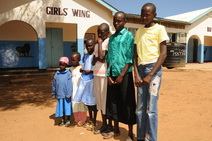 |
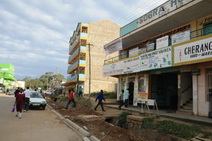 |
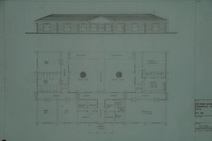 |
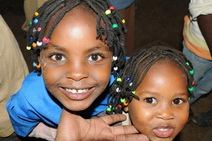 |
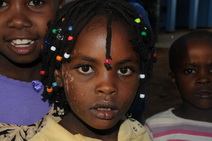 |
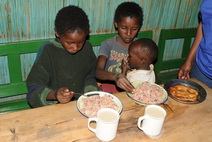 |
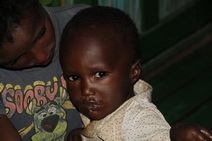 |
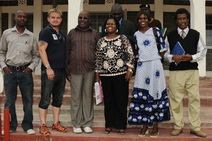 |
 |

